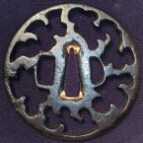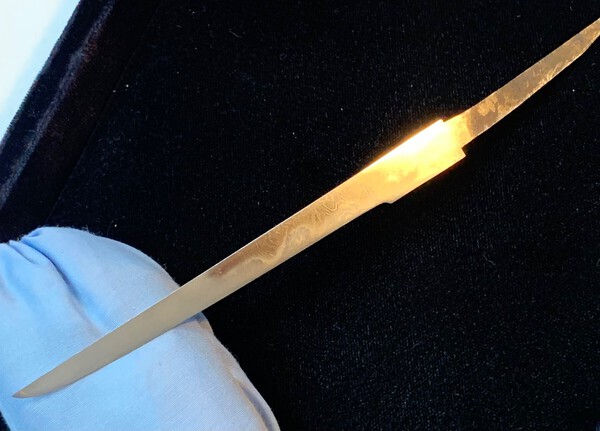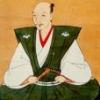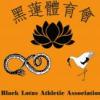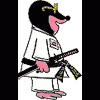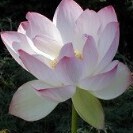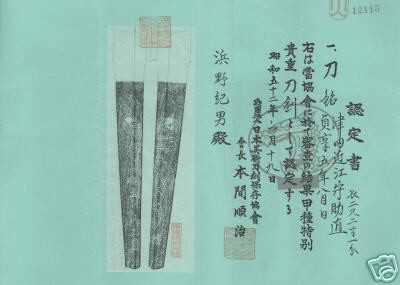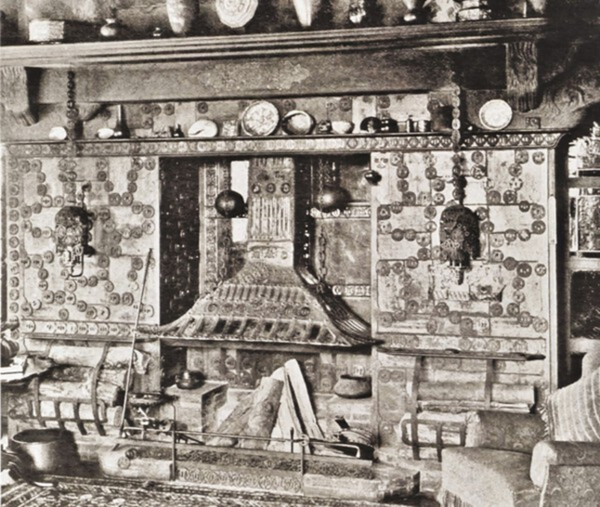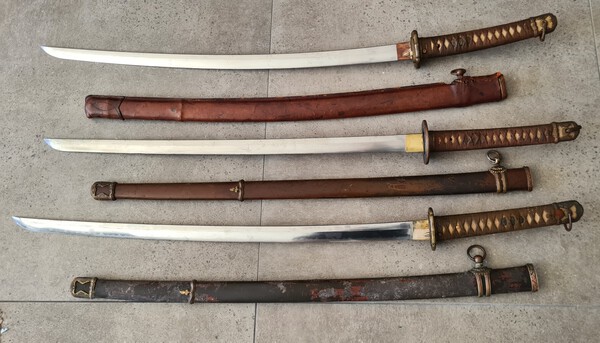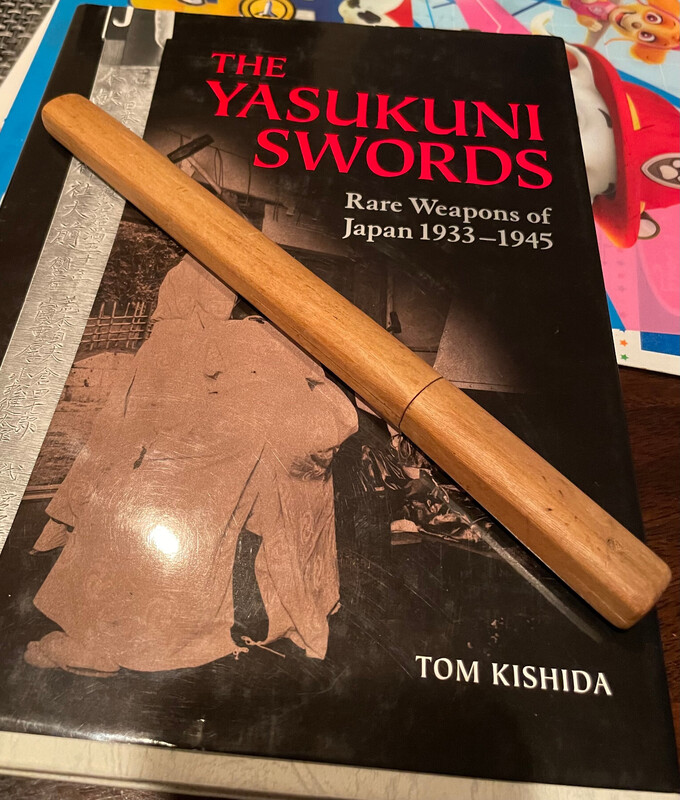Leaderboard
Popular Content
Showing content with the highest reputation on 01/16/2022 in all areas
-
5 points
-
If I understand the question: Tokubetsu Kicho are not on the same level as Juyo. I came to Nihonto about the time that the NBTHK made the change from Kicho and above to Hozon and above. At that time I was told that they were also upping their expectations to qualify for a paper: Hozon would roughly equal the old Tokubetsu Kicho and Tokubetsu Hozon would roughly equal the old Koshu Tokubetsu Kicho. Not all of the old papers are suspect. An old green paper to Muramasa or Masamune on a sword or Nobuiye or Kaneiye on a tsuba, say, are to be eyed suspiciously but, for less important artists, not so much. Grey4 points
-
+1 There’s no point in buying what you don’t like for any reason. As Paul Bowman says, buy what you like, then do the study to learn why you like it.4 points
-
Did someone say "Beetlejuice" three times? Yes, the Chicken still lives, but has been away for a time now, with military/riot shotguns supplanting the nihonto itch. You may thank (or castigate) BaZZa for trolling up this fowl member. I hope to attend the No. Cal. Token Kai this year after two misses due to Covid and cancellations. It is, alas, time in life to consider de-accession as opposed to accumulation and find new caretakers. Have no feeling at this time as to the nihonto market place, need to study up here, I guess. The koshirae that kicked off this thread are indeed quite nice, very refined. I have a near complete chicken set, rather beefy, minus the tsuba, that are more "over the top", but no candidate sword on which to fit them. Oh, well. Anyway, hi to all who remember da Chicken, fondly or else. I will try (and likely fail ) to abstain from further recommending the Jim Kurrasch power uchiko method for removing clouds and rust fron newbies' swords. Hope everyone here had a great winter solstice season (is this PC enough?), and have an equally rewarding 2022.4 points
-
I can't. To add to the complexity of this art or hobby interest, the difficulty of passing Juyo has changed over the years. --There are some Juyo that I think would barely pass TH. Conversely, there are some tsuba that would barely make Tokubetsu Hozon these days that are Juyo. Omissions like why no Juyo Saotome? There are a few incredible ones, but I've been told "There are no Juyo ones, so the NTBHK won't make any Juyo" And so on. Incredible work by Jussi.4 points
-
4 points
-
3 points
-
Ah, thanks, Glen, for the explanation. I appreciate it. Yes, I can see why you had these statements in your post, then. I guess I would just say that, while Nidai work can be as good as that of the two Shodai smiths, I wouldn't quite say it is on another (higher) level. His workmanship can be more complex, it is true (e.g. he will sometimes have, in combination, uchikaeshi mimi, extremely expressive tsuchime, brilliant tekkotsu, and the finest amida-yasuri of any tsubako in history, IMHO), but conversely, it doesn't quite attain the hugely expressive sculptural power of the work of O-Shodai, and it lacks the nuanced finesse often achieved by the Meijin-Shodai. None of these qualities would make one "better" than the other, objectively speaking, but subjectively, certainly, we might prefer the tsuba of one of these smiths to those of the other. In my view, all three are absolute masters. Interesting note: the Nidai has five Juyo pieces to his name, while the O-Shodai (Yamasaka Kichibei) has "only" four. However, it must be considered that there are far fewer O-Shodai pieces extant, so a much higher percentage of his known works are Juyo than is the case with the Nidai. This, incidentally, must be factored in when we are reviewing how many Juyo works exist for a given smith or "school": how many pieces made by a particular tsubako are there, and of these, what percentage attain Juyo levels? In some cases, there may be hundreds of pieces extant belonging to a certain maker or school, but "only" perhaps ten are Juyo; on the other hand, there may be only a few dozen works known by another master, but of these, ten are Juyo. This may suggest a higher "ranking" for the latter... I'll look forward to reading your further posts in this and other threads, Glen. Steve3 points
-
I can't get a "Kuni" out of this nakago. And IMHO the suke part is pretty dodgy. In a real sense, tho, that doesn't matter. What this sword tells me about is 1) the tragedy of Japan's involvement in the War, with them trying to produce swords when aircraft carriers and tanks were deciding the conflict, and 2) the clear evidence that swordsmithing in Japan is a complex - well- "art" that involves thorough mastery of blacksmithing and tangential crafts like signing an art name with a chisel. I find this sword tragic. Peter2 points
-
國 (or 国 in its abbreviated form) has a calligraphic form that is very highly stylized. The stylized form has no box around it. It is one of those calligraphic forms that look absolutely nothing like its normal form, and makes people scratch their heads. https://word.4ndex.com/name/2-1/215-kuni.html Plus, if I'm not mistake there were at least two gunto smiths who used the name Sukekuni. I don't know which one this is. His calligraphic style should give him away.2 points
-
Back to Gwyn’s question, I agree with comments above that many tsuba and perhaps sword fittings in general are undervalued today in terms of the effort and artistry put into their creation. At the time of manufacture, I think the cost of the raw materials would have been comparatively little compared to the hours put into forging a steel plate, cutting sukashi or carving nikubori. Lord only knows the skill, time and patience that went into creating a high quality nanako ground. Steel tsuba, historically I feel would be ascribed an aesthetic value because of demand by warriors who liked the more austere wabi-sabi look. Gradually more complex designs in steel evolved as peace-time created the leisure to make and appreciate them. For me, it is especially these that are undervalued today and I would cite better pieces from Bushu, Echizen, Hizen and Choshu schools as examples of this. At the other end of the scale, I think there was always a demand for works by the Goto and, later, by the machibori masters that inflated their prices as these were the province of the well heeled. Sorry for the long post.2 points
-
Piers, that has a lot going for it, and no matter how much you downplay it...it's a lovely piece that most of us would like to own. As far as the Gunto aspect, you have great quality fittings. Has a nice civilian habaki. Has a mon. And I daresay upgraded high class seppa. And then you add an older blade in good condition. What more could you want? It's the whole package. And......a big AND....You can see that Gunto are the sword investment of the future in Japan. We can already see how prices have risen.2 points
-
I really would like to buy into this discussion, realizing that I don't have the scholarship, the knowledge that comes from dedicated research and comprehension of the extensive study of tsuba schools and tsuba generally that many here so obviously have achieved. Because there are so many tsuba available and still coming onto the market, people like me can poke and prod around the periphery and from time to time find an example to take pleasure in AND often enough for not a lot of money. I only ever wanted a few reasonably good examples (or what I thought was reasonably good), particularly from the pre- Edo period (and that wasn't always that easy to define) and without paying very much for any piece (say $1200US maximum). Not that I didn't like outstanding pieces but it was late in my life and money wasn't that available. Now I didn't collect to try and impress or please anyone else except me and so I am quite OK with what I have, others may smile at them but anyone can enjoy this genre of collecting, more and more so when you see and read articles like the above. On the other hand, one piece I would really love to have is an example illustrated in the publication "LETHAL ELEGANCE" on page207-no.135 Tsuba with design of "flying goose, reed and stream", can I be greedy and say- plus most of the others as well. My poor computer skills don't let me show you them. What I have tried to illustrate is that is not too late and not very expensive to build some sort of tsuba collection with examples of your liking. Roger j2 points
-
Mark S. Who or how can anyone define a 'proper' collection? Two tsuba could be called a collection [albeit a small one]. Basing your collection on is probably the most honest and important way to do it. Go for it!2 points
-
2 points
-
Hi Piers, worth the wait for the reveal. Those are good quality mounts, probably pre 1941. Good result, any Gunto collector would be happy to have a sword like it!2 points
-
Last night I took it to the local NBTHK meet, and asked if the Sensei would look at it for me. He drew it out, dismantled it and examined the blade and nakago. 「まじめなものです。」"Majime na mono desu." he declared, something like, "nothing suspicious about it". My sword polisher picked it up, with "Wow, it's heavy!" An iai practitioner reached out for it and swung it gently. "No, this is just the right balance," he said. Swords from this smith (line of smiths) are said to be sharp, but then that whole area has that reputation. As to the blade itself, it is generally suguha, with a clearly defined boshi. "You are lucky that this one has registration paperwork", someone added. Coincidentally he had a gunto with him as part of the evening's exercise, containing a Tamba no Kami Yoshimichi with a chrysanthemum stamp in the nakago. (Kyoto) A few blade shots follow... with luck. PS Did I mention that I only bought this for the pleasure of the membership? I have not yet decided whether to keep it or release it back into the wild.2 points
-
2 points
-
2 points
-
I would tend to go along with Jean & Curran - try getting someone to make a quality tsuba today, the cost of labour would be prohibitive compared to what you would pay for an antique piece. It would seem that the sheer number of tsuba available does factor into it, there are stories that at the turn of the twentieth century tsuba were sold by the barrel load or for pennies apiece. As collections took off and collectors increased in number, demand started to dictate prices a lot more. But I can also see that many pieces particularly in auctions can sell very cheaply one day and almost identical ones can fetch thousands the next. I have yet to see any real consistency with prices or find the rationale of what makes one more expensive than another based on a like for like comparison.2 points
-
The cost of tsuba varies greatly, from a couple of hundreds to thousands. Types vary enormously and everyone has a particular favourite. Sometimes l am amazed that some types that seem very very simple iron works to me command such high prices. Some to my eye even look crudely made and yet are quite expensive. My question is this. Does the price of tsuba today reflect the price that it cost to buy when it was made, or has rarity and collectors tastes dictated that an otherwise cheap tsuba now costs a lot lot more?1 point
-
Here I go again, wandering away off the original track/thread but JFYI the Australian aboriginals had no musical instruments (except in the Northern Territory- Arnhem Land area where they had the 'didgeridoo', a wooden drone tube), instead, everywhere else they only had 'clap sticks' or two boomerangs clacking together to beat time during their frequently held Corroborees/ sing songs. Basic but effective. Some of you might like to add that not very useful information to your lexicons of trivia. Roger j1 point
-
Awesome job Glen. As tsuba and other fittings are not my forte, if you guys find any errors you can message me and I will correct it for the next update. I was trying to look into the Nanban tsuba that is being discussed, unfortunately I can't get the text typed in today and trying to figure it out. It has been attributed to Momoyama period by NBTHK. The size of it is 7,4 cm X 7,3 cm.1 point
-
Antler and bone are primarily ossein, and have a Mohs hardness of around 5. Ivory, tusk and tooth are primarily dentin, and have a Mohs hardness of around 3.5. Horns and claws are made up primarily of keratin (the protein found in hair, fingernails, and animal hooves), surrounding a core of live bone. Keratin has a Mohs hardness of around 2.5.1 point
-
Hum... Sorry but you lost me there, what do you mean exactly? That the sword is worth more than only Hozon? Why is the subject sword only Hozon and not Tokubetsu Hozon? It could be that the submitter only wanted to verify the mei and stopped when it passed Hozon, not continuing on to challenge Tokubetsu Hozon. It's also the case that the NBTHK will let you know when an item will not be considered for higher papers. It could also be that TH was challenged and it didn't pass. If it was submitted, then why didn't it pass TH? It's signed and dated, no obvious visible problems of any kind really. Considering the price jump if did pass TH, at least in my mind raises suspicions that this sword just doesn't meet the quality requirements of TH. And that question needs to answered before buying. Mass production Koto period Bizen swords aside, it would be advisable to read what Yamanaka and Nihonto Koza has written about later Koto Bizen swords in general when considering buying one. Yes, buy what you like, but know what you're buying. NBTHK shinsa standards ... http://www.nihontocraft.com/Nihonto_Shinsa_Standards.html .1 point
-
1 point
-
John J., I like your "then do the study to learn why you like it" comment... I like so many that I think I would need some professional help to unpack it all And just to add to your comments about "the well heeled", it's always good to remember that beginning sometime in the Edo period, swords were not exclusively worn by the samurai class. The wealthy merchant class were allowed to wear a single sword on their person, while samurai were required to wear two. The wealthy merchants would have definitely driven up the price of the high end tsuba back in the day. Mark H., I like the "mountain analogy" in the link you posted... it could be applied to the varying levels of skill and abilities for just about any aspect of human activity. As for Dale's comment about people buying tsuba by the barrel full after the samurai were no longer permitted to wear swords, Louis Comfort Tiffany did exactly that! One of his his purchases was for a batch of 2500 tsuba! He had so may, that he nailed them to his smoking-room wall and had them mounted in his blacksmith-made smoke hood for his fireplace:1 point
-
Ok, thanks guys! Not part of my normal area of study, but always good to learn new stuff.1 point
-
John That has re-iterated my thinking I believe the papers associated in the scandal were for sword only as the profit margins could be astronomical whereas much more difficult with tosogu Some of the attributions for the Birmingham tsuba are just silly, just an observation for people thinking museums are perfect. But I digress1 point
-
1 point
-
Although I haven’t mentioned it above, it has been discussed many times on this site before, but for anyone living here in Japan it is also important to be aware that… …the back of the registration card specifies that if you plan to keep an antique blade or gun, you must register your new ownership with the local Board of Education by post within three weeks of purchase.1 point
-
The short answer Ken is that it is MUCH safer to obey the law and keep strict control over the correct paperwork. It doesn’t come naturally, but I know several Japanese people who have spent time in prison for getting it wrong. The police will interrogate, and one by one they will pull everyone even remotely involved. Smaller blades are no problem, as long as you don’t carry them on your person or in your car. Even a fruit knife can get you into trouble. TPO. Most of the larger blades I’ve owned have come and gone. Now I have only one Yari left, for example, but the blade itself is short enough not to need registration. Right. The gunto. Registered, so no problem. The original card must remain at all times with the blade. I borrowed a furoshiki cloth from the dealer, to carry it wrapped up to the parking lot. Then I carried the furoshiki back to the stall. If I’d had an accident on the way home I would have had to explain to any cop that spotted it that I had just bought it and was carrying it straight home. Your story must be clear, and be corroborated with witnesses. Any credible dealer would always be ready to deal with that and back you up. If carrying it for any other purpose the cops would contact the other person to check out your story. Not sure if this answers your question Ken. In some ways things are easier once everyone knows the rules. Much more paranoia in Europe for example, where there are grey areas galore. Your collection would never be arbitrarily confiscated by the cops in Japan if for example a nosy neighbor decided to shop you as some kind of ‘scary weapons maniac’.1 point
-
Join the crowd, Piers. I did the same a few months ago, & am still wondering why.1 point
-
Thanks for the additional details Steve It certainly adds more depth and nuance to "all things Yamakichi" Mark S. - like Spartancrest (Dale) said, go with what appeals to you. For a great place to start for information on various tsuba schools and representative examples, I would definitely suggest Ed Long and Robert Haynes' website shibuiswords.com. Just don't pay too much attention to the prices. Look at it more like a relative ranking of the tsuba that are listed on the site, then go hunting for ones that you admire. Because of the breadth of time and immense quantities of tsuba produced in Japan, a tsuba collection could probably take on a nearly infinite number of goals and themes. It will ultimately be a very personal endeavor, but hopefully one you can share with all the other crazy people who love tsuba. I'm hoping to get to the point where I need to reinforce my floors so the collection doesn't fall through to the basement one day1 point
-
Excellent. A couple of sources say that Kiyosada was also written 清定 but that they were the same person.1 point
-
Thanks Bob. It really is satisfying isn't it I thought I may have gone through the patina in a spot or two on another tsuba, but wasn't sure if it's because the antler had gotten through an area where maybe the rust went deeper into the tsuba? I'm not sure if it works like that because the patina itself is just its own form of oxidation (similar, but different to red rust). Anyway, I'll have to keep an eye on that in the future, so thanks for tip1 point
-
Steve, I looked through my files to see if I could find the info, and it's actually something you wrote: "The Nidai Yamakichibei worked in Owari during the late-Momoyama Period to the earliest years of the Edo Period, creating powerful tsuba strongly informed by the Tea taste of the Tea Master Furuta Oribe. His works are esteemed as among the greatest iron sword guards in Japanese history: within the Yamakichibei group of tsubako, it is the Nidai who has the most Juyo tsuba, with five. His work is not frequently encountered." - S.Waszack It was the combination of: "it is the Nidai who has the most Juyo tsuba" and "among the greatest iron sword guards in Japanese history", that lead me to the inference that their work would be "more highly prized". It seemed like a logical leap to me, but It is an inference, and I could be wrong. As to the "next level statement", that's just a personal observation, therefore purely a matter of opinion. To my eye, there appears to be an increased level of complexity in form and texture in the second gen Yamakichibei tsuba. And I know that increased complexity doesn't automatically mean "better", but in this case, it seemed to qualify as "next level" in terms of the relative complexity in the designs in the 2nd gen tsuba. Steve, you are the expert in the Yamakichibei area, and defer to your knowledge and insights. If there's some errors in my thinking, I'm all ears Thanks!1 point
-
1 point
-
You need to Google “hidari” Kaneyasu who had the title Mutsu (no) kami and compare the workmanship of his blades with yours. This is the smith that Jean is referring to who wrote his kanji backwards.1 point
-
LOVING IT SO FAR Guys.. PLEASE carry on. I want to learn. Can anyone post example photos side by side so we can compare and contrast? i.e. an elaborate work that is quite inexpensive with a simple one that is costly. (Must point out that I am not bitching about prices in this thread, I realise that they cannot be made today without breaking the bank, and that they are all superb value considering age and craftsmanship I am just interested in how prices compared way back then for different types and why prices vary so much today even one tsuba is so elaborate and another seems basic.)1 point
-
Bugs Love love all the hiboil of your talking to yourself. Good to know im not alone in the world. On the edge of my seat mate, maybe a shot of the registration paper first? going to go make some popcorn.1 point
-
Nicolas, a nice package, an interesting blade with lots of HATARAKI (as far as I can see), a simple but tasteful KOSHIRAE in very good condition - vas-y si tu as les sous!1 point
-
Something I’ve just noticed is that by running the two characters together it does give an impression of 越 Etsu, as in Echizen越前、Etchū 越中 and 越後 Etchigo.1 point
-
That’s true Thomas! The fact that he didn’t sign with that name (at the latter Edo period) may be an indicator that this affiliation is fictitious….1 point
-
Knowing the maker is always good and important, and in this case the maker seems to be a smith of some skill, so I wouldn't say this is insignificant. Also, the unique design on the tang, and even the "good luck" inscription on the reverse side, will all be interesting to collectors. For sure get a new mekugi. Many of us here on the board just whittle down a piece of bamboo chopstick when a new one is needed. (Nobody is a purist regarding the menuki...any piece of bamboo will do as long as it stays in place and holds the sword in). Regarding restoration, for now I wouldn't be in a rush. Just keep it oiled very slightly (so that a film covers the sword, but not enough to allow the oil to collect and pool and potentially drip inside the saya). With Shōwa blades, restoration is always a dicey proposition because the cost of restoration may not be recovered when reselling. I know you are not considering reselling, but it is a data point that someone will eventually consider. I don't know too much about Kanemitsu, but the inscription is unusual enough, that the sword may well be worth spending the couple of thousands of dollars on restoration. Think about this for a while, get some more opinions, show to some collectors or dealers in your area.1 point
-
Just some ponints to consider here: Aoi Art works with stock in Japan and in almost all cases these swords have been looked after better than some in the West so the nakago patina is less marred by active rust. They also stock swords from all periods, increasingly more recent ones so nakago from Shinshinto might well look very clean, from WWII swords even more so, shinsakuto of course. Cleaned nakgo are a big downpoint so any swords that had been so abused would have had the patina restored. I have seen clean nakago on the website, but not cleaned, and no Japanese polisher would ever do such a thing. Hope that helps. All the best.1 point
-
Mid-January update. On Thursday I’ll probably let go of the latest handachi Koshiraé without creating a new tsunagi for it. Someone else can make that commitment. Bought on impulse. Straight back into the pot. The gold Kiri Mon on Nanako Shakudo Fuchi/Kashira are good quality, so I am sure it will find a new owner. The Kagami-Shi Tsuba is par for the course. The cheering news is that having recently bought a mumei Muromachi/Momoyama(?) Jumyō Tantō in Yamanouchi Mon, (see a few posts above), I’ve coincidentally found a Tosa Yamanouchi gun to go with it. Sitting in traffic today, I was thinking that now I have at least one object from the Hosokawa family of Kumamoto, the Daté families of Uwajima and Sendai, the Ikeda of Tottori and Okayama, Hachisuka of Awa/Tokushima, Toyotomi Hideyoshi, Tokugawa, and the Yamanouchi of Tosa, inter alia. Each is an express elevator back in time. Close your eyes and you’re there.1 point
-
Just got this one, similar to Pier's first post, as a gift from someone very gracious. Mumei, and the nakago looks new to my eyes, though with some rust. Shirasaya seems to have some age, but not a great amount. I'm thinking post-war souvenir? Mostly because the habaki is fairly ugly and long. Most of it slides into the tsuka with only the "normal" amount sticking out, to look like a habaki. And also the squared and thick nakago. But I wanted to run it through you guys. I'd like to buff it up, but I don't want to if it's something older. If it's just a trinket/souvenir/letter opener then I'd feel easy with cleaning off the rust.1 point
-
Juan, not a dagger (= both sides sharp), but a nice little TANTO. It is difficult to judge by photos alone, but to me the shape looks older than EDO JIDAI.1 point
-
Let me clarify, "this school" when I wrote above means Horikawa school. Kawachi no Kami Kunisuke, first generation, is taught by Horikawa Kunihiro. He is a Horikawa school smith by his training. Kunihiro is famous for making blades that have been confused with Masamune and is quoted out as copying Masamune. Yamanaka indicates influences on Kunihiro include Shizu, Sa, Akihiro and Hiromitsu. He also made excellent Yamashiro style works. Note in this that Masamune and Shizu are often interchangeable (with some famous Masamune becoming Sadamune and then Shizu down the road). Yamanaka writes: "Horikawa Kunihiro: made in the old traditional Soshu style." He further goes on to state: "Kawachi no Kami Kunisuke was the student of HIROKAWA KUNIHIRO of Kyoto and he supposedly went to Osaka about the same time as IZUMI no KAMI KUNISADA and though the exact date is not known, it is popularly assumed to be about the Shoho or the Keian Era. Although KUNISUKE made blades in the Shinto Tradition, there are very few of these and those that are generally seen are like those of his teacher KUNIHIRO, that is in the Koto Tradition." Kunihiro was making the Soshu style blades in the latter half of his life, when he was teaching all of the great students that he had. Making Sadamune and Shizu type blades was popular with Umetada Myoju too and these techniques got taught to Shodai Tadayoshi as well, where we see the Soshu style works he made at the very beginning of his career before focusing on late Rai style Yamashiro type blades which would become the backbone of Hizen. From the examples here, he appears strongly influenced by one of the work styles of Go Yoshihiro. For the record the comparison Go on the right was known as a Go in the Edo period. And below we see his work which is either based on Shizu or Sadamune. In this case the NBTHK says Shizu, but we see this hamon pattern in Sadamune as well. What we don't see in Shizu is this combination of horimono and a strong commonality with Sadamune works is that they frequently exhibit bonji, futasuji hi, suken, gomabashi, and many other things, several at a time, often assymetrical ... and seeing that to me it looks like an intention then to homage Sadamune on this one. But the point all of this raises is that it can be difficult to know which Soshu smith is being targetted, especially because these smiths have handed down mostly mumei swords and the attributions have changed over time. Masamune in Kunihiro's time, as mentioned, may have been Sadamune by the time of Honami Kozon and Shizu by the time of the current NBTHK. In the case of the elongated kissaki this should steer us to Sadamune and Shizu, smiths coming a bit after Masamune as it is a feature that belongs to the middle to late Nanbokucho rather than the Kamakura/Nanbokucho boundary where Masamune resides. The students I expect would have all been trained in what the master knew, and the influence on the work of some is probably greater than in others. But we do see Sadamune/Shizu/Soshu influence in Kunisuke works, as in these below. On the left it is a typical Soshu style wakizashi with horimono and yubashiri to the point of hitatsura on one side and muneyaki. In the middle is a Sadamune style wakizashi with quiet notare based hamon with ashi, gunome mixed in and a bit of togariba. This can be confusing because this shape of blade and style of hamon we can also feel to be influenced by Shizu and togariba is a stronger connection to Shizu. The katana on the end is a Soshu style hamon with gunome mixed into notare, and sunagashi and kinsuji and looks more like Go than anything. Without that blade getting polished and a close look at it, it's not clear what the style is, my only comment is based on the narrow seeming shingogiji to wide ji ratio resembles the Soshu work of Sadamune and Shizu and knowing Horikawa school copies these (and other Soshu smiths, I've had this same layout on a Yukimitsu), is what draws my reaction. As a side note we do see choji in Yamashiro and Soshu, especially in Ayanokoji and in Rai. Kunihiro is not known as a Bizen smith but as one familiar in Soshu and Yamashiro. Is it more likely then that choji comes from Bizen than Yamashiro teachings in the works that inherit from him? Kunisuke's "choji" is often gunome rather than an Ichimonji style choji. I'm not making any argument for or against here, just pointing out that his teacher was making Yamashiro and Soshu den and his own work has a lot of gunome and notare in it. The below two examples are more of the same that is based in Soshu den. There are ongoing attempts to create hitatsura like features, with yubashiri appearing and muneyaki, and in the case of the naginata he's completed the tempering throughout the shinogi-ji. This is not Bizen den, and not Yamashiro den, this is rooted in Soshu.1 point



